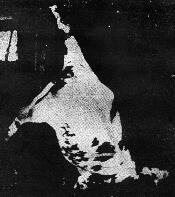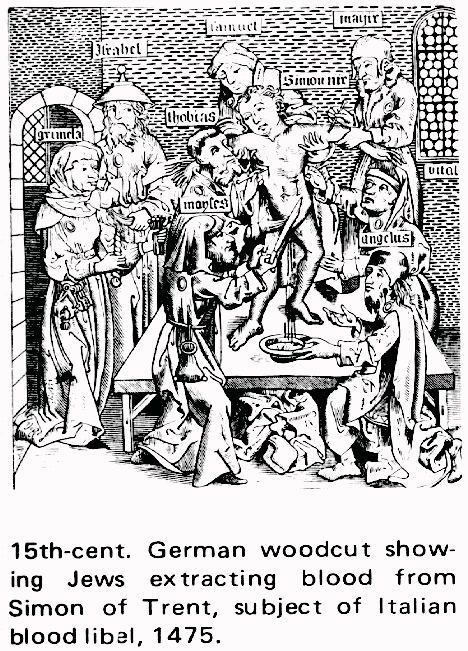There appear to be two reasons why this advertisement was placed:
(1) The advertisement was placed because Jewish ritual slaughter tends to be inhumane
It would appear that Jewish ritual slaughter tends to be inhumane, as demonstrated in the following excerpt from the advertisement. (All ellipses and all insertions within square brackets in this passage appeared in the original advertisement with one exception � the material shown between square brackets in a blue font had been deleted from the New York Times advertisement, and has been put back in by myself. I found the deleted material in Seymour E. Freedman, The Book of Kashruth: A Treasury of Kosher Facts & Frauds, Bloch Publishing Company, New York, 1970, p. 43.)
|
"A number of years ago the Federal inspectors ruled that no animal is to be slaughtered with its head resting on the floor probably for sanitary reasons. Therefore the animal is slaughtered while hanging in the air suspended by its hind legs with the head at the right height for the shochet [Jewish slaughterer] to reach it. In order to do this properly it must be forced to remain perfectly still during the time of slaughter. To render it incapable of movement, a rope is attached to one of its front legs, then tied securely to the wall by means of pulley and hooks while the head is made secure and immobile.... A plier with an iron hook at either end is inserted in the animal's nostril [and] tightened.... The plier is then pulled by a rope and secured to the opposite wall so that the front leg is pulled to one wall while the head with the help of the hooks is pulled to the other wall, thus subjecting it to the most excruciating pain imaginable.... The animal generally screams and bellows with agonizing pain until the shochet cuts its throat thus putting it out of its misery." Excerpts from a shochet's report, Jewish Press. Jan. 13, 1961. "In a Kosher plant I recently visited, the hoist was operated until the steer was hanging suspended by the leg with its face partly on the floor. The slaughterhouse worker then turned the hose on the animal's face and neck so that the animal got the full force of the water[, and then I witnessed something I had read about as occurring in Kosher plants, that I could scarcely believe when I read it. The packing-house employee deliberately plunged both his hands into the steer's eyes until the eyes were displaced by being pushed back into the head.] He then grasped the sides of the eye sockets and held the animal that way while the shochet, the man who performs the kosher slaughter, stepped forward to cut the steer's throat. The hoist was then operated again until the animal's head was several feet from the floor and the animal was moved along the motor driven line, hanging head downward, its full body weight suspended by the shackled hind leg, ... every part of the body quivering.... While the struggling was going on, the shackle was released and the steer was dumped on the floor, still ... moving convulsively. These, in my judgment, were not post-mortem reflexes. They were too violent. This entire procedure ... was routinely and systematically carried out on all of the animals I watched being slaughtered." Excerpts from a statement by the president of a national humane society at a public meeting of Friends of Animals, Inc., Feb. 5, 1967. |
Two photographs accompany the New York Times advertisement, which given that my copy of the advertisement was made from microfilm, I have only extremely poor copies of � nevertheless, I reproduce a small version of one of these photographs which shows a cow hanging by one hind leg, with its neck and head resting on the floor � who knows for what reason? Maybe this cow is already dead; but maybe it is alive and conscious, and ready to have an assistant hold its head from within its eye sockets so as to prevent its struggling to escape during the work of the Jewish ritual slaughterer.

In connection with the shackling and hoisting depicted above, a source other than the New York Times advertisement that we are discussing offers the following observation:
|
For while the act of shechita [ritual slaughter] itself is humane, the method of restraining the animal prior to the slaughter (as has been practiced in the past and even today) is generally recognized as far from perfect. The shochet [ritual slaughterer] is the first to admit this. The method (known as "shackling and hoisting") currently employed in most abattoirs consists of shackling the back feet of the animal with chains, and then hoisting it off the floor so that its head hangs down awaiting the shochet's knife. It is presumed (with some justification) that hanging an animal of eight to fifteen hundred pounds from the ceiling by its hind legs is a painful, frightening experience for the animal.
Seymour E. Freedman, The Book of Kashruth: A Treasury of Kosher Facts & Frauds, Bloch Publishing Company, New York, 1970, p. 33. |
To Freedman's statment, we might feel an obligation to add several qualifications: (1) that the act of shechita (ritual slaughter) itself is humane is capable of being doubted, as will be discussed below; (2) shackling and hoisting alone do not produce the degree of immobilization that the Jewish ritual slaughterer requires, which may call for some further measure to be taken prior to throat slitting, such as an assistant thrusting his fingers into the animal's eye sockets, as described above; (3) if shackling and hoisting a cow by both hind legs can be assumed to be painful, then shackling and hoisting the cow by one hind leg, as pictured above, must be assumed to be even more painful.
(2) The advertisement was placed because the non-kosher public unwittingly eats meat that comes from Jewish ritual slaughter
| KOSHER OR NON-KOSHER � THE MEAT YOU NOW BUY IS RITUALLY SLAUGHTERED. About 90% of all ritual slaughter is sold without the kosher designation. The cruelty, then, continues largely because the non-kosher consumer unknowingly pays for it through his meat purchases. |
We understand, of course, that 90% of ritual-slaughtered meat being purchased by non-kosher consumers is not at all the same as 90% of meat purchased by non-kosher consumers coming from ritual slaughtering.
The goal of the New York Times advertisement, then, can be re-formulated as (1) to halt inhumane slaughter, and (2) to propose the means by which this halt can be achieved � which is by identifying for consumers meat that originates from ritual slaughter, which will cause them to avoid it, and which in turn will bring economic pressure to halt the practice:
| The kosher consumer has already obtained the full protection of the state: When he buys kosher meat the law assures him that it is the product of ritual slaughter. The state owes the non-kosher consumer equal protection in the law: You have a right to know that the meat you buy has been slaughtered by modern methods. The section of the bill reprinted below protects you � and the animals as well, because this law will force the slaughterhouses, through economic necessity, to modernize the ritual. |
